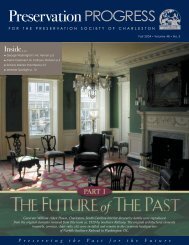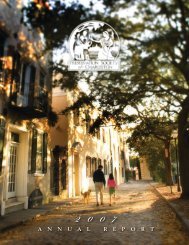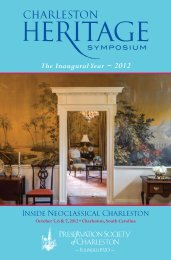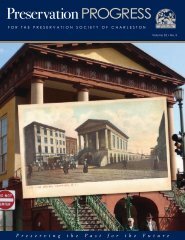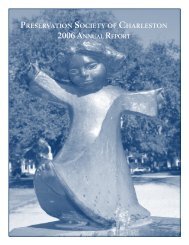download pdf - Preservation Society of Charleston
download pdf - Preservation Society of Charleston
download pdf - Preservation Society of Charleston
- No tags were found...
Create successful ePaper yourself
Turn your PDF publications into a flip-book with our unique Google optimized e-Paper software.
8 <strong>Preservation</strong> PROGRESS <strong>Preservation</strong> PROGRESS 9<br />
y<br />
y<br />
THE GARDENS OF LOUTREL BRIGGS (1893-1977)<br />
Loutrel Briggs photo: courtesy <strong>of</strong> Post and Courier<br />
Editor’s Note: The following is an interview with Sheila Wertimer, ASLA. In addition to her being a member <strong>of</strong> the <strong>Society</strong> and formerly serving on<br />
our Board <strong>of</strong> Directors, she is a highly respected landscape architect with a flourishing practice – specializing in rehabilitating old and/or historic<br />
gardens plus designing new ones imbued with that elusive quality <strong>of</strong> tradition, heritage and time-proven charm. She is among a group <strong>of</strong> local pr<strong>of</strong>essionals<br />
who have undertaken the daunting but important task <strong>of</strong> documenting the remaining <strong>Charleston</strong> gardens designed in the first half <strong>of</strong> the<br />
last century by the remarkable Loutrel Briggs – possibly the one landscape architect singularly responsible for defining what, today, is considered the<br />
“classic <strong>Charleston</strong> garden.”<br />
A formal rose garden<br />
Q. For the uninitiated – who was Loutrel Briggs And how did he become so closely associated with<br />
the historic gardens <strong>of</strong> <strong>Charleston</strong>, South Carolina<br />
A. Actually, Loutrel Winslow Briggs was not a <strong>Charleston</strong>ian – or even a Southerner. He was born in New York City<br />
in 1893. He graduated from Cornell University (as did I). His degree (earned in 1917) was in “rural art” (today known<br />
as landscape architecture) and he became head <strong>of</strong> the department <strong>of</strong> architecture at the New York School <strong>of</strong> Fine and<br />
Applied Art. His early life is wonderfully outlined in his 1951 book, <strong>Charleston</strong> Gardens, (University <strong>of</strong> South Carolina<br />
Press) which is out <strong>of</strong> print, unfortunately, but it’s a fascinating resource for understanding his point <strong>of</strong> view. He had<br />
traveled extensively in Europe and much <strong>of</strong> what he absorbed there <strong>of</strong> the European/English traditions in gardening<br />
found an appreciative audience here.<br />
He first came to <strong>Charleston</strong> in the late 1920s. It was a time when a number <strong>of</strong> wealthy Northerners were “rediscovering”<br />
the city’s architectural charms. They were purchasing town homes and plantation properties as wintertime retreats.<br />
Briggs had a large following in New York and he was asked by some <strong>of</strong> those clients to design gardens for their <strong>Charleston</strong><br />
properties. His first local commission was in 1929 for Mrs. Washington Roebling, widow <strong>of</strong> the famous engineer who<br />
supervised the construction <strong>of</strong> the Brooklyn Bridge. She was restoring the (1772) Gibbes House at 64 South Battery<br />
which includes one <strong>of</strong> the city’s largest formal gardens. Not long after that, he opened a <strong>Charleston</strong> <strong>of</strong>fice and spent his<br />
winters living and working here until he retired to <strong>Charleston</strong> in 1959.<br />
Q. Then, would he be considered among those people associated with “the <strong>Charleston</strong> Renaissance” (<strong>of</strong> the 1920s and<br />
30s)<br />
A. I would say so, yes. He certainly became extremely popular among <strong>Charleston</strong> property owners during that<br />
period and remained so well past that time even into the 1960s. He was widely sought out, his work was <strong>of</strong>ten<br />
published in national magazines, and his book quickly became something <strong>of</strong> a local classic. Even today, when<br />
clients say to me, “I want to have a formal <strong>Charleston</strong> garden,” what they’re really saying is – I want a garden like<br />
Loutrel Briggs designed for <strong>Charleston</strong>’s beautiful 18th and 19th century homes.<br />
Q. Was he working from a historical context – replacing what had been here in the 18th and 19th centuries<br />
A. I don’t think so. There’s some historical record <strong>of</strong> early formal gardens being in the City <strong>of</strong> <strong>Charleston</strong>, but<br />
they weren’t extensive and even they were echoes <strong>of</strong> much earlier European gardens. In actuality, the side yards<br />
and rear gardens <strong>of</strong> most early <strong>Charleston</strong> homes were small urban farms. You would have found more milk<br />
cows and chickens, vegetables and herbs growing there than exotic ornamentals. Loutrel Briggs’ bias toward formal<br />
European landscape design was ideally suited to <strong>Charleston</strong>’s architecture as it was “idealized” later on – in<br />
his own time. He liked to create a series <strong>of</strong> garden “rooms” divided into a hierarchy that related logically to the<br />
architecture. For instance, his more formal spaces are adjacent to the house – intended to be looked down upon<br />
from a piazza. The farther removed from the house, the more informal the garden spaces become. This intimate<br />
relationship between the garden and its architectural host was a European concept that was seen in <strong>Charleston</strong>’s<br />
earliest gardens, but Briggs revived the tradition and refined it.<br />
Q. What are the other typical characteristics <strong>of</strong> a Briggs garden<br />
A secluded path leads to romantic ruins<br />
▼<br />
A. That’s really quite interesting. From his accounts, we’re learning that his palette <strong>of</strong> plants<br />
and colors actually evolved as he became more adept working with this southern climate and<br />
his <strong>Charleston</strong> commissions grew in number. Still, he worked with a fairly narrow scope<br />
through most <strong>of</strong> his career. You will almost always find azaleas, camellias, a dogwood tree and<br />
usually a focal point (or points) frequently in the form <strong>of</strong> a water feature. He was incredibly<br />
prolific and meticulous in his record-keeping. That’s been a boon to our study. We’ve identified<br />
at least a hundred Briggs gardens in the Lowcountry so far. And the number could easily grow<br />
as more documentation is found.<br />
Q. What is the Loutrel Briggs Survey<br />
A. In the spring <strong>of</strong> 2003, a group <strong>of</strong> pr<strong>of</strong>essionals and preservationists set out to survey the contribution <strong>of</strong> Briggs<br />
in a definitive way – as much <strong>of</strong> his work was seriously being eroded by changes in property ownership, poor maintenance,<br />
natural disasters and the passing <strong>of</strong> time. Even the documentation <strong>of</strong> his known work was spread over<br />
several resources. The survey evolved from dialogue between the <strong>Preservation</strong> <strong>Society</strong> and Historic <strong>Charleston</strong><br />
Foundation over the deteriorating status <strong>of</strong> some <strong>Charleston</strong> gardens. The effort was joined by the South Carolina<br />
Historical <strong>Society</strong>, the <strong>Charleston</strong> Garden Club, The <strong>Charleston</strong> Horticultural <strong>Society</strong>, Briggs biographer and garden<br />
writer James Cothran, Clemson Architecture Center director Robert Miller, and a number <strong>of</strong> local landscape<br />
architects who directed staff time to the project.<br />
Q. What does the Briggs survey hope to accomplish<br />
. We set out to identify, document, photograph, and preserve as many Briggs gardens as are still with us. To do<br />
this, we had to devise a survey form, coordinate volunteers, contact property owners identified as owning a Briggs<br />
garden, and archive the information for the public’s future use in a working data base that can be maintained and<br />
updated as changes occur. It’s still a work in progress.<br />
In my practice, I’m frequently asked to restore a garden originally designed by Briggs or we’re asked how to retain the best Briggs elements while updating a garden<br />
for more contemporary use. The survey will help me (and others) know where and what Briggs designs are still out there and how best to preserve them and/or restore<br />
them, appreciate them, and live with them for today’s purposes as well as tomorrow’s enjoyment.<br />
The <strong>Preservation</strong> <strong>Society</strong>’s Executive Director Cynthia C. Jenkins stressed the importance <strong>of</strong> the Loutrel<br />
Briggs Survey to the city this way. “According to the guidelines set forth by the Department <strong>of</strong> Interior, a<br />
property qualifies for the National Register through its location, design, setting, materials, workmanship,<br />
feeling, and association. Of these seven key “integrities” – the surrounding gardens or the landscape <strong>of</strong> a<br />
property engage three; design, setting and feeling. The remarkable garden designs <strong>of</strong> Loutrel Briggs are<br />
clearly integral to the historic fabric <strong>of</strong> this city.” ■<br />
HOW WIDESPREAD WAS BRIGGS’ DESIGN PATH<br />
Although the complete inventory <strong>of</strong> Loutrel Briggs’ garden designs is still incomplete, the impressive<br />
volume <strong>of</strong> his known work is evident in this partial listing provided by the study. His popularity with<br />
<strong>Charleston</strong> residents speaks eloquently <strong>of</strong> his sensitivity to the relationship between historic homes and the<br />
garden environments surrounding them.<br />
Loutrel Briggs completed designs and/or actual gardens for properties on the following streets in<br />
<strong>Charleston</strong>: Anson, Atlantic, Bedons Alley, Catfish Row, Chalmers, 16 properties on Church, East Battery,<br />
4 properties on East Bay, Elliott, Greenhill, 11 properties on King, Ladson, 4 properties on Lamboll, 9<br />
properties on Legare, Lowndes, 9 properties on Meeting, 2 properties on Murray Boulevard, 3 properties<br />
on Orange, 2 properties on Rutledge Avenue, 3 properties on <strong>Society</strong>, South Adgers Wharf, 8 properties on<br />
South Battery, 2 properties on State, 9 properties on Tradd, and Water. He also created gardens for Mepkin<br />
Plantation, McLeod Plantation, Mulberry Plantation, Rice Hope Plantation, the Francis Marion Tomb, and<br />
Strawberry Chapel. ■<br />
This corridor <strong>of</strong> brick piers frames several garden rooms<br />
Focal point <strong>of</strong> a garden ruin



